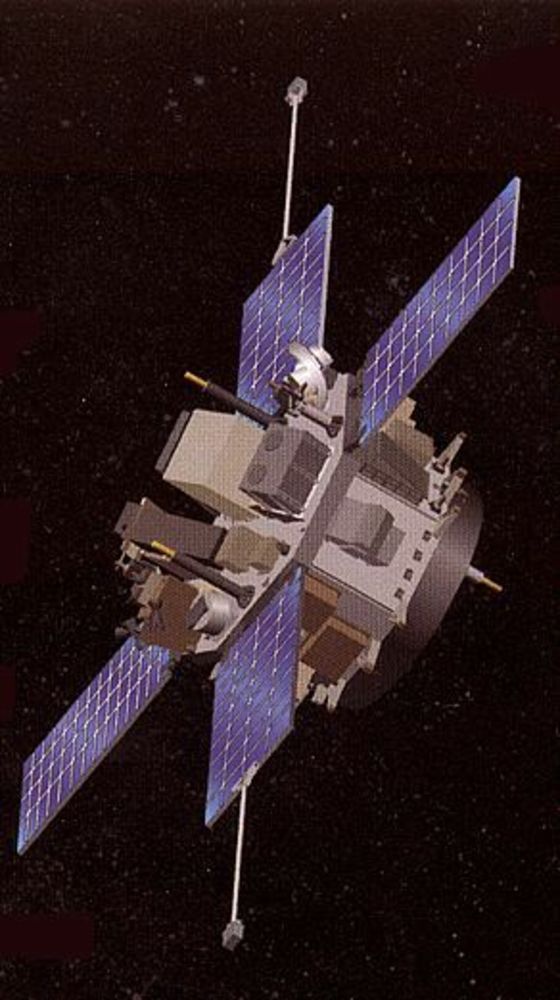Planet Earth Online - Space Weather Forecasts
Interview with
Chris - Although it's a popular conversation topic - it's very tricky to predict the English weather. But what about if you wanted to predict the weather in space? Richard Hollingham is just back from a space insurance conference - I didn't know there were such things - that took place in Italy where 'space weather' forecasting was the hot topic of the day among those responsible for operating satellites and insuring spacecraft...
Richard - I'm walking across a park in the centre of Rome and, well, the weather is lovely. Clear blue sky, slight wispy clouds, a light breeze, but that's only half the story. Richard Horne is here from the British Antarctic Survey. What's going on then beyond the atmosphere - beyond that 'plane we can see in the sky?
Richard H. - Well we're familiar with the terrestrial weather but actually out in space we also have weather, so to speak. We call this space weather. It really is driven by variations on the Sun - we have the material flowing off the Sun which we call the solar wind. It flows towards the Earth and that can disrupt technological systems, modern technology.
Richard - Now, David Wade, you're from Atrium Insurance. Satellites - that's what you're worried about because you insure them. What impact can this stream of charged particles from the Sun have?
David - It can have a number of impacts. One of the most obvious ones to think of would be a loss of power. The Sun pours out some protons, those protons hit the satellite solar arrays and the solar arrays are degraded, but you can also get charging, where different parts of the satellite charge up at different rates and then an arc forms between the two differently charged parts, and when that arc discharges it could cause damage to the satellite.
 Richard - What sort of impact would that have on us?
Richard - What sort of impact would that have on us?
David - Typical impacts could be the loss of communication services, but other aspects such as the GPS system - the navigation system that we've all become so used to these days. We think of it as directing us when we're driving our cars, but it has much wider uses than that; financial transactions, mobile phone towers. All of those are governed by the timing signals that we get from the GPS system.
Richard - So potentially you could lose almost all communications if you knocked out for example GPS?
David - Absolutely. GPS is a constellation of satellites so there are numerous satellites up there, so chances are you may not knock out all of them together. But you could certainly get a degraded service. And that could also be a degraded navigation service; you could see the impact on flights or shipping which may not be able to dock at a particular time.
Richard - Are we talking here, Richard about a hypothetical situation or could this really happen?
Richard H. - No, there are examples where this has really happened in the past. If we go back to 2003, there was a very big magnetic storm at the Earth. Something like 47 satellites were reporting malfunctions. One satellite was a total loss - that was a scientific satellite. It was a Japanese one. It cost 640 million dollars, that's a lot of money. Indeed, over the next few years we are expecting a number of magnetic storms to increase. We know that the Sun has an 11-year solar cycle and we usually measure that by the number of sunspots. But in terms of the magnetic storms, we can also measure that at the Earth, and we measure that by the changes in the Earth's magnetic field. We know that the number of storms is going to increase typically one to two years after the solar maximum, the maximum sunspot number. So over the next three to four years, there's going to be a period of increasing risk, when storms occur and those storms damage satellites and a variety of other infrastructure.
Richard - You say risk - can you see those coming?
Richard H. - At the moment, it's very unreliable. The best we can do really is to take information from a particular spacecraft called ACE (the Advanced Composition Explorer), and it measures the magnetic field flowing off the Sun. We can then combine those measurements with computer models and try and make a forecast of what's going to happen at the Earth.
Richard - That's fine but how far forward can you predict?
Richard H. - By taking measurements of ACE, we've got something like half an hour to one hour's forecast time. Having said that, once the geomagnetic storm starts, what we've established already is that there's something like a four to five-day period that satellites are most at risk and trying to determine how long that period would last and then when it will be safe. That's vitally important to operators, particularly if they want to do orbit manoeuvres or uploading of software and do other kind of operations.
Richard - What would you like to do then?
Richard H.: We're just starting a new project, it's called Spacecast, and we're going to take data from satellites, and we're going to try and generate a forecasting capability. It's an interest for the insurance companies because they want to be reassured that the operators are taking all measures possible to try to reduce the risk of damage and loss.
Chris - Dr Richard Horne from the British Antarctic Survey and David Wade from Atrium Insurance on the impact of space weather on satellites.
- Previous How You Use Your Handset
- Next Metal Casting with Precision










Comments
Add a comment